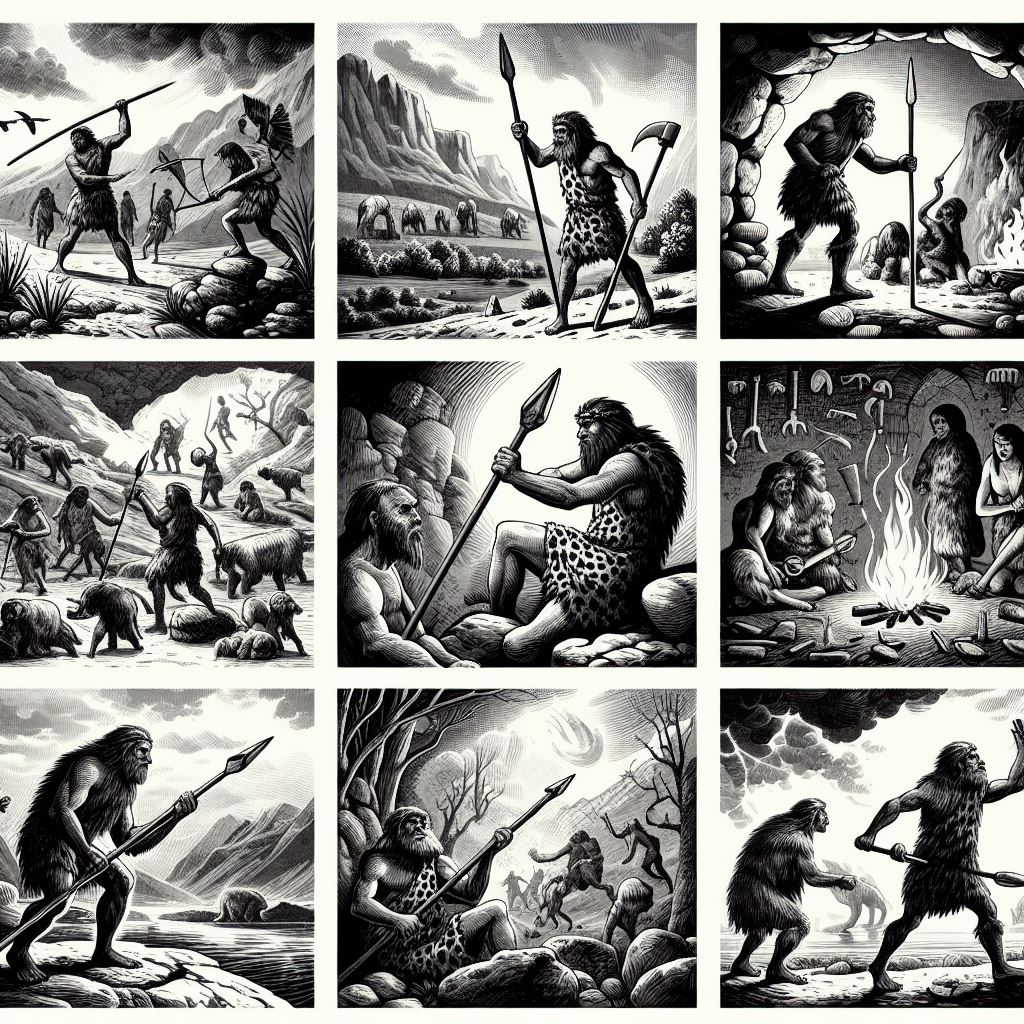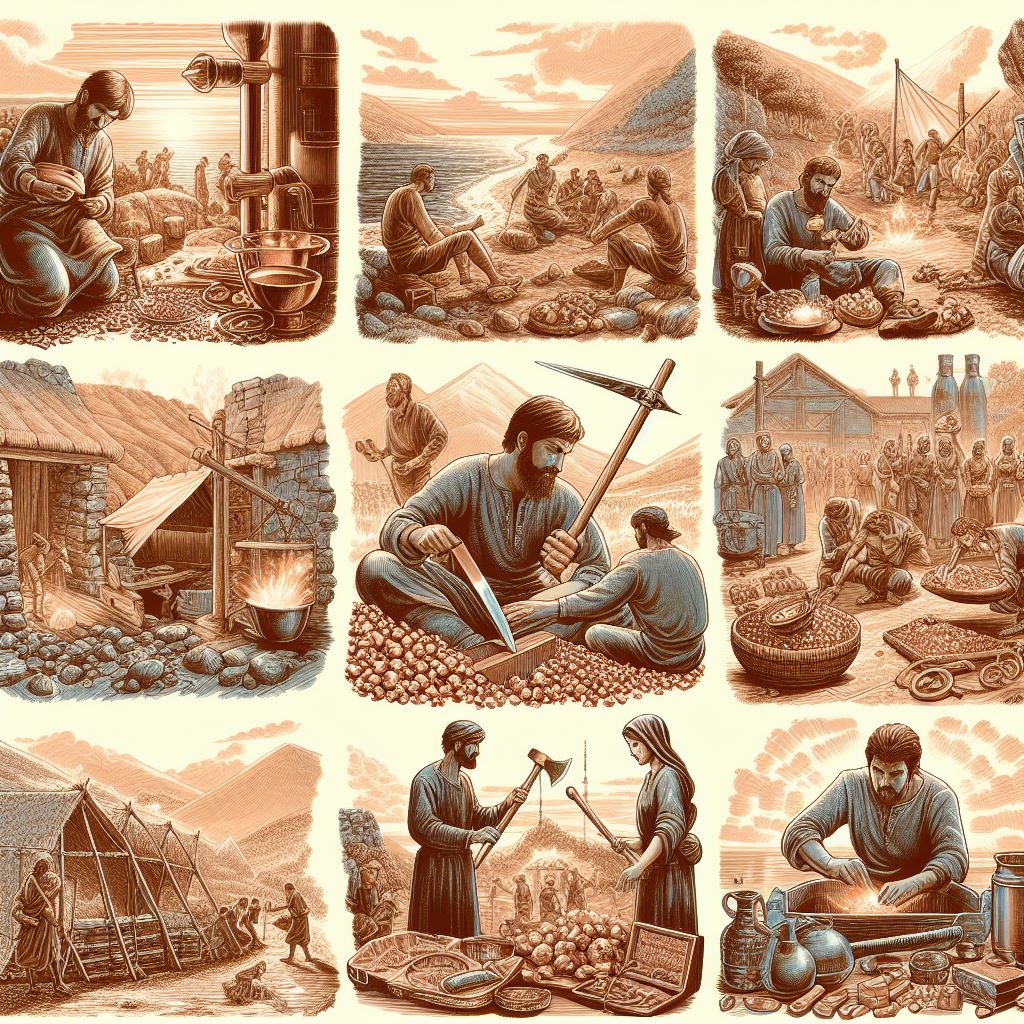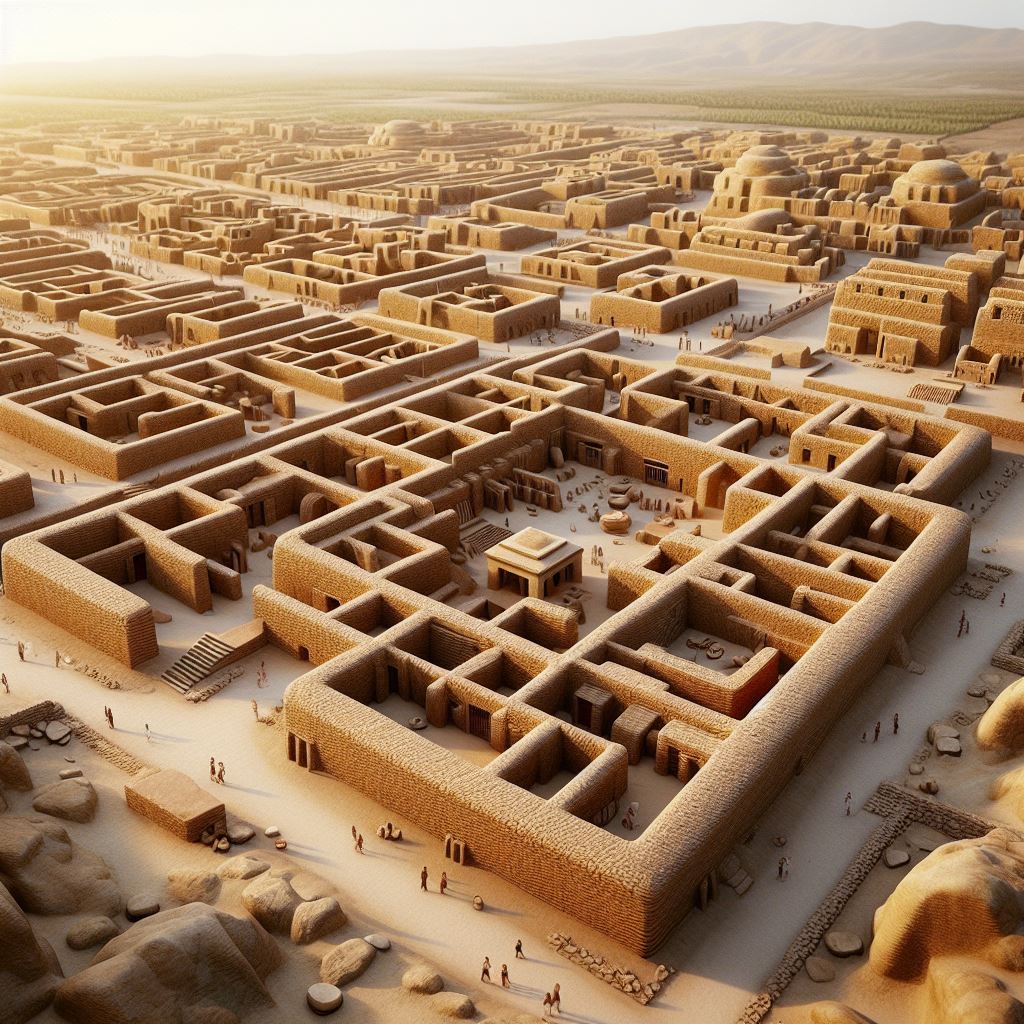Introduction to The Stone Age
Have you ever wondered what life was like for our ancient ancestors? Imagine a world without
smartphones,
cars, or even basic writing systems. Welcome to the Stone Age - a fascinating era that shaped
the
course
of human history! 🗿
.jpeg)
From crafting rudimentary tools to developing complex social structures, our prehistoric
forebears
laid
the groundwork for modern civilization. But how did they survive in such harsh conditions? What
were
their daily lives like? And most importantly, what can we learn from their experiences? Join us
on
an
exciting journey through time as we uncover the mysteries of the Stone Age, exploring everything
from
primitive technology to early artistic expressions. Prepare to be amazed by the ingenuity and
resilience
of our distant relatives as we delve into their world of The Stone Age: history, tools,
lifestyle, key discoveries and primal
survival skills.
Understanding the Stone Age
A. Definition and time period
The Stone Age represents a vast period in human prehistory, spanning approximately 3.4 million
years
and
ending between 8700 BCE and 2000 BCE, depending on the region. This era is characterized by the
widespread use of stone tools and the gradual development of human technology and culture.
|
Period
|
Time Range
|
Key Features
|
| Early Stone Age |
3.4 million - 300,000 years ago |
Simple stone tools, fire use |
| Middle Stone Age |
300,000 - 50,000 years ago |
More advanced tools, early art |
| Late Stone Age |
50,000 - 8700/2000 BCE |
Complex tools, agriculture |
B. Significance in human evolution
The Stone Age played a crucial role in human evolution, marking significant milestones in our
development:
- Cognitive advancements
- Tool-making skills
- Social organization
- Language development
- Artistic expression
These developments laid the foundation for future human societies and technological progress.
C. Major subdivisions
The Stone Age is typically divided into three main periods:
- Paleolithic (Old Stone Age)
- Longest period
- Nomadic hunter-gatherer lifestyle
- Simple stone tools
- Mesolithic (Middle Stone Age)
- Transitional period
- More sophisticated tools
- Beginning of settled communities
- Neolithic (New Stone Age)
- Development of agriculture
- Permanent settlements
- Advanced tool-making techniques
Each subdivision represents significant shifts in human capabilities and societal structures. As
we
explore these periods, we'll gain a deeper understanding of our ancestors' journey towards
modern
civilization.
Tools and Technology
Early stone tools
The development of stone tools marked a significant leap in human evolution. Early hominids
crafted
simple tools from readily available materials, primarily flint and other hard stones. These
tools,
known
as Oldowan tools, were created by striking one stone against another to produce sharp edges.
|
Tool Type
|
Purpose
|
Materials
|
| Choppers |
Cutting and chopping |
Large pebbles or cobbles |
| Hammerstones |
Striking other stones |
Round, hard stones |
| Flakes |
Cutting and scraping |
Sharp stone fragments |
As time progressed, more sophisticated tools emerged, such as:
- Hand axes: Versatile tools used for various tasks
- Cleavers: Larger, heavier tools for breaking bones
- Scrapers: Used for preparing animal hides
Fire mastery
The control of fire was a revolutionary achievement that transformed Stone Age life. Fire
provided:
- Warmth and protection from predators
- A means to cook food, improving nutrition
- Light for extended activities after dark
- A focal point for social gatherings
Stone Age people learned to create fire using friction methods, such as the hand drill or bow
drill
techniques. They also developed ways to transport and maintain fire, crucial for survival in
harsh
environments.
Hunting weapons
As hunting techniques evolved, so did the weapons used. Stone Age hunters crafted increasingly
sophisticated tools, including:
- Spears: Long wooden shafts with sharpened stone points
- Atlatls: Spear-throwers that increased throwing distance and power
- Bolas: Weighted cords used to entangle prey
These advancements allowed for more efficient hunting of larger game, contributing to improved
diets
and
population growth.
Pottery development
Towards the later part of the Stone Age, pottery emerged as a crucial technology. Early pottery
was:
- Hand-formed without the use of a wheel
- Fired in open pits rather than kilns
- Decorated with simple patterns using fingers or tools
Pottery revolutionized food storage and cooking practices, enabling:
- Long-term storage of grains and liquids
- New cooking methods, such as boiling and stewing
- The development of fermented beverages
These technological advancements laid the groundwork for future innovations and the transition to
more
complex societies.
Lifestyle and Social Structure
Nomadic existence
The Stone Age was characterized by a largely nomadic lifestyle, with early humans constantly on
the
move
in search of food and resources. This mobile existence was crucial for survival in a world where
resources were scattered and seasonal.
Key aspects of nomadic life:
- Frequent relocation
- Lightweight, portable possessions
- Adaptability to various environments
- Extensive knowledge of terrain and natural resources
Hunter-gatherer societies
Hunter-gatherer societies formed the backbone of Stone Age social structure. These groups were
typically
small, consisting of extended family units or bands of related individuals.
|
Activity
|
Role
|
| Hunting |
Primarily men |
| Gathering |
Mostly women and children |
| Tool-making |
Skilled individuals |
| Child-rearing |
Communal effort |
Cave dwellings
While not all Stone Age people lived in caves, these natural shelters played a significant role
in
early
human habitation. Caves provided protection from the elements and predators, serving as both
temporary
and long-term dwellings.
Emergence of settled communities
Towards the later part of the Stone Age, some groups began to transition to a more settled
lifestyle.
This shift was largely driven by the development of agriculture and animal domestication.
Factors contributing to settled living:
- Reliable food sources
- Improved storage techniques
- Population growth
- Development of specialized skills
This gradual change in lifestyle laid the foundation for more complex social structures and the
eventual
rise of early civilizations. As we explore further, we'll see how these settled communities
influenced
the development of art and culture in the Stone Age.
Art and Culture
Cave paintings and their significance
Cave paintings offer a fascinating glimpse into the artistic and cultural expressions of our
Stone
Age
ancestors. These ancient artworks, found in various locations worldwide, serve multiple
purposes:
- Historical record
- Spiritual significance
- Communication tool
- Artistic expression
|
Purpose
|
Description
|
| Historical record |
Depictions of daily life, hunting scenes, and animal species |
| Spiritual significance |
Representations of religious beliefs and rituals |
| Communication tool |
Sharing information and stories across generations |
| Artistic expression |
Demonstration of creativity and aesthetic sensibilities |
The most famous cave paintings, such as those found in Lascaux, France, and Altamira, Spain,
showcase
remarkable artistic skill and attention to detail. These works provide invaluable insights into
the
cognitive abilities and cultural sophistication of our Stone Age ancestors.
Stone Age jewelry and personal adornments
Early humans adorned themselves with various forms of jewelry and decorative items, demonstrating
their
creativity and desire for self-expression. Common materials used include:
- Shells
- Animal teeth and bones
- Polished stones
- Feathers
These adornments likely served both aesthetic and social purposes, potentially indicating status,
group
affiliation, or personal achievements.
Early forms of music and dance
While direct evidence of Stone Age music is scarce, archaeological findings suggest that early
humans
engaged in musical activities. Bone flutes and other primitive instruments have been discovered,
indicating the importance of sound in Stone Age culture. Dance, though leaving no physical
traces,
was
likely an integral part of social gatherings and rituals.
Ritual and spiritual practices
Stone Age communities developed complex belief systems and spiritual practices, as evidenced by:
- Burial rituals
- Megalithic structures
- Figurines and sculptures
These practices reflect early humans' attempts to understand and interact with the world around
them,
forming the foundation for later religious and philosophical traditions.
Diet and Nutrition
A. Common food sources
The Stone Age diet was diverse and varied depending on geographical location and seasonal
availability.
Here's a list of common food sources:
- Wild game: Mammoth, deer, bison, and smaller animals
- Fish and seafood: Various species from rivers, lakes, and coastal areas
- Nuts and seeds: Acorns, hazelnuts, and pine nuts
- Fruits and berries: Wild apples, berries, and other foraged fruits
- Roots and tubers: Wild yams, carrots, and other underground plant parts
- Leafy greens: Wild herbs and edible leaves
B. Cooking methods and utensils
Stone Age cooking methods were primitive yet effective:
|
Method
|
Description
|
Utensils Used
|
| Roasting |
Cooking meat over open fire |
Wooden spits, hot stones |
| Boiling |
Heating water with hot stones |
Animal hide containers, wooden bowls |
| Stone boiling |
Dropping hot stones into liquid-filled containers |
Animal hide or wooden containers |
| Pit cooking |
Burying food with hot coals |
Digging tools, leaves for wrapping |
C. Nutritional value of Stone Age diet
The Stone Age diet was rich in nutrients:
- High in protein from lean meats and fish
- Rich in fiber from fruits, vegetables, and nuts
- Low in processed carbohydrates
- Abundant in vitamins and minerals from varied plant sources
- Healthy fats from nuts, seeds, and fish
D. Impact on human evolution
The Stone Age diet played a crucial role in human evolution:
- Brain development: High protein and fat intake supported brain growth
- Digestive adaptations: Humans developed enzymes to process new foods
- Physical changes: Jaw structure evolved due to softer cooked foods
- Social development: Hunting and gathering promoted cooperation and communication
Now that we've explored the dietary habits of our Stone Age ancestors, let's examine how these
early
humans created shelter and established their living spaces.
Technological Advancements
Fire control and its importance
Fire control was a pivotal technological advancement in the Stone Age, revolutionizing human
life.
Its
mastery provided numerous benefits:
- Heat source for warmth
- Light for extended activities
- Protection from predators
- Cooking food, improving digestion
- Tool-making capabilities
|
Aspect
|
Without Fire
|
With Fire
|
| Food |
Raw, limited options |
Cooked, expanded diet |
| Safety |
Vulnerable to predators |
Enhanced protection |
| Tools |
Basic stone tools |
Heat-treated, stronger tools |
| Social |
Limited night activities |
Extended social interactions |
Language Development
Language development marked a significant leap in Stone Age technology. It enabled:
- Complex problem-solving
- Knowledge transfer between generations
- Coordinated hunting strategies
- Social bonding and cultural development
Early forms of agriculture
The transition to agriculture was a game-changer:
- Cultivation of wild plants
- Development of farming tools
- Establishment of permanent settlements
- Surplus food production
Domestication of animals
Animal domestication complemented agricultural advancements:
- Reliable food source (meat, milk)
- Labor assistance (plowing, transport)
- Materials for clothing and tools (wool, bones)
- Enhanced security (guard dogs)
These technological advancements laid the foundation for future civilizations, marking the end of
the
Stone Age and the dawn of more complex societies.
Stone Age Communication: Signs, Symbols, and Sounds
Communication in the Stone Age was primarily non-verbal and relied on gestures, sounds, symbols,
and
rudimentary tools. Here are some key methods:
1. Oral Communication
- Early humans likely used grunts, clicks, and simple sounds to convey emotions, warnings, or
needs.
- Over time, these evolved into more structured speech.
2. Body Language and Gestures
- Hand signals and facial expressions were crucial for survival, especially during hunting or
conflict.
- Pointing, waving, or mimicking actions helped convey messages.
3. Cave Paintings and Rock Art
- Early humans painted on cave walls using natural pigments (charcoal, ochre, etc.).
- These paintings depicted hunting scenes, rituals, and possibly storytelling or spiritual
beliefs.
4. Symbols and Petroglyphs
- Engraved symbols on rocks or bones may have been early forms of written communication.
- Some patterns could represent maps, counting systems, or tribal markings.
5. Drums and Sound Signals
- Hollow logs or drums were used to send signals across long distances.
- Clapping stones or whistling might have also played a role in alerting or gathering groups.
6. Smoke Signals and Fire
- Fire was used for signaling danger, marking locations, or coordinating hunting parties.
- Different patterns of smoke may have had specific meanings.
7. Tokens and Knots
- Some evidence suggests early humans used tied knots in string or small carved objects to
keep
track of numbers or agreements.
Over time, these primitive methods laid the foundation for the development of spoken language and
writing systems.
Conclusion
The Stone Age was a pivotal era in human history, marked by significant advancements in tools,
technology, and cultural practices. From the development of stone tools to the emergence of
intricate
cave art, our ancestors demonstrated remarkable ingenuity and adaptability. The hunter-gatherer
lifestyle, diverse dwelling structures, and evolving dietary habits all played crucial roles in
shaping
early human societies.
As we reflect on this fascinating period, it's clear that the innovations of the Stone Age laid
the
foundation for future civilizations. The technological progress made during this time continues
to
influence our understanding of human evolution and capabilities. By studying the Stone Age, we
gain
valuable insights into our past and a deeper appreciation for the journey that has led us to our
modern
world.
advertisement
 Testing Ads on Our Website - Thank You for Your Patience!
Testing Ads on Our Website - Thank You for Your Patience!
Dear Visitors,
We are currently testing advertisements on our website to enhance user experience and explore
potential partnerships. During this phase, you may notice changes in ad placements or content.
We apologize for any inconvenience and appreciate your patience as we fine-tune the system. If
you have any feedback or concerns, feel free to reach out to us through our contact page.
Thank you for your support!
Vastusthiti Team
.jpeg)

 Watch Video
Watch Video
 Introduction to The Stone Age
Introduction to The Stone Age
 Understanding the Stone Age
Understanding the Stone Age
 Tools and Technology
Tools and Technology
 Lifestyle and Social Structure
Lifestyle and Social Structure
 Art and Culture
Art and Culture
 Diet and Nutrition
Diet and Nutrition
 Technological Advancements
Technological Advancements
 Stone Age Communication
Stone Age Communication
 Conclusion
Conclusion
 Download Images
Download Images
 Facebook
Facebook
 X (Twitter)
X (Twitter)
 LinkedIn
LinkedIn
 Instagram
Instagram
 Telegram
Telegram
 Whatsapp
Whatsapp

.jpg)
.jpg)
.jpeg)
.jpg)
.jpg)
.jpeg)
.jpg)
.jpg)
.jpeg)
.jpg)


